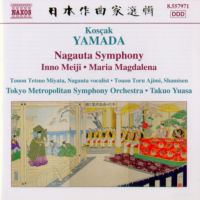
Fascinating and Rewarding
Works by
Kosçak Yamada,
heard by
PATRIC STANDFORD
Naxos 8.557971
|

|
Kosçak Yamada is regarded as the one composer who made the most important contribution to the introduction and development of Western styles in Japanese music. Born in 1886 into a modest family, his early life exposed him more to the Protestant Western musical tastes of his parents than to local musical traditions. After the loss of his father the family endured years of hardship, relieved eventually by a generous brother-in-law who encouraged and enabled him to enter the Tokyo Music School, a centre of Western culture. In 1910 he went to Berlin as a student with Max Bruch and absorbed there the prevailing styles, being particularly influenced by Richard Strauss -- as this closing extract from his Choreographic Symphony Maria Magdalena of 1918 suggests.
Listen -- Maria Magdalena (track 3, 14:06-15:23)
© 2007 IVY Corporation and Naxos Rights International Ltd
In time Yamada became intrigued by the possibilities of combining Western materials with Japanese, and in the single movement Nagauta Symphony 'Tsurukame', written in 1934, he introduced a quintet of nagauta vocalists as an integral component of his score.
Listen -- Tsurukame (track 1, 15:48-17:20)
© 2007 IVY Corporation and Naxos Rights International Ltd
During the 1920s Yamada composed a great many songs and nursery rhymes, a preoccupation that earned him the title 'Japanese Schubert', and many of his songs remain popular today. He travelled widely and was the first to demonstrate to Europeans and Americans that the Japanese could compose and conduct. He befriended the young Shostakovich and conducted the first Japanese performance of his First Symphony. In his Sinfonia Inno Meiji of 1921, he manages the integration of an ensemble of traditional instruments -- the three-stringed shamisen, fues (flutes), the double-reed hichiriki, and various percussion.
Listen -- Inno Meiji (track 2, 14:22-16:05)
© 2007 IVY Corporation and Naxos Rights International Ltd
Yamada died in 1965, a pioneer of significant westernisation in the musical growth of 20th century Japan. A fascinating and rewarding CD.
Copyright © 17 May 2008
Patric Standford, Wakefield UK

Yamada: Nagauta Symphony
8.557971 DDD Stereo NEW RELEASE 51'31" 2007 IVY Corporation and Naxos Rights International Ltd
Touon Tetsuo Miyata, Touon Toshimitsu Muraji, Touon Taro Yamaguchi, Touon Jun Ajimi, Touon Keizo Miyata (Nagauta vocalists, Nagauta Symphony); Touon Toru Ajimi, Touon Takehisa Takahashi, Touon Shiro Minoda, Touon Yutaka Miyata, Touon Gojiro Sakamoto, shamisen (Nagauta Symphony); Sataro Mochizuki, Satatoshiro Mochizuki, Tatsuyuki Mochizuki, Roei Tosha, Toru Fukuhara, hayashi (Nagauta Symphony); Yumiko Mizoiri, hichiriki (Sinfonia); Tokyo Metropolitan Symphony Orchestra; Takuo Yuasa, conductor
Kósçak Yamada (1886-1965): Nagauta Symphony 'Tsurukame' (1934); Sinfonia 'Inno Meiji' (1921); Choreographic Symphony 'Maria Magdalena' (1916-18) |
BUY THIS CD ONLINE
Record Box is Music & Vision's
regular series of shorter CD reviews
|

